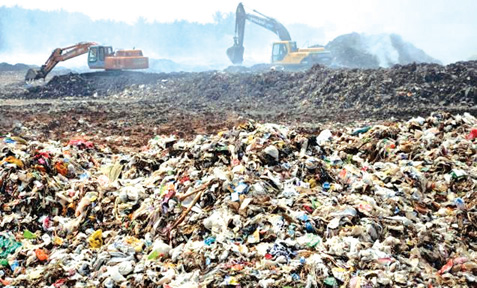Conserving the environment
by R.R.S. Perera
In the natural world people, animals and plants live and we call it
the environment. The undisturbed environment sustains the balance
between each other naturally.
|

A garbage heap makes an unpleasant environment |
The environmental pollution distorts this natural balance causing
severe damage to humans and other species. Most of the time pollution of
the environment is caused due to human activities. The pollution of
land, air, water and sound make the earth unsuitable for living.
In simple terms, land pollution is the destruction of earth surfaces
and misuse of land resources.
The main cause for this pollution is the solid waste. This is
disposed from houses, schools, hospitals, markets and workplaces. The
biodegradable solid waste such as food, paper and grass are less harmful
whereas things such as plastic, aluminum, car parts and broken
electronics gadgets are more harmful because they do not decay easily.
Dumping of these cause generating of unpleasant odour, spreading of
flies and rats, heap of garbage which make an unpleasant environment.
Deforestation is a prime cause for this type of pollution.
This is done for farming and mining purposes. Excessive usage of
pesticides and fertiliser can pollute the soil.
The main consequence due to the land pollution is that toxic
substances get into the human body. The possible ways for this are
breathing polluted dust particles and eating of vegetables and fruits
grown in polluted soil. Sometimes these toxics may wash into water
sources thereby affecting the people who consume water of these sources.
Pollution
The air pollution occurs when gases, fumes and odour are introduced
into the atmosphere. The main pollutants for this are Sulpher Dioxide,
Nitrogen Oxide, Carbon Monoxide and Carbon Dioxide.
These are toxic gases emitted from industries, burning of Fossil
fuels and manufacturing activities both in farming and household such as
fumigating, cleaning, painting, pest killing and use of weedicides and
insecticides are influenced such pollution too.
When the above mentioned air pollutants are combined with water
droplets, an acidic rain is formed. This process is called
acidification. This is harmful to animals, fish and the wildlife.
Sometimes the acidification may change the soil chemistry. This in turn
could affect vegetation. The eutrophication is another adverse effect
caused due to pollutant Nitrogen. The Nitrogen is a nutrient for herbs.
This gets deposited in natural water sources such as rivers and lakes.
This leads to the growth of algae, which results in consuming of
oxygen dissolved in the water. As a result, a threat of starving of
oxygen is occurred to the aquatic creatures. Another way of polluting
the air is particles of lead and mercury introduced by activities of
household and farming. Depending on the length of the time of exposure
and concentration of the chemicals, this may cause irritation to the
eyes, nose and throat and respiratory infections.
Human activities
The contamination of water bodies by human activities is referred to
as the water pollution. One reason could be mixing of hazardous
substances with water. This could happen due to the chemicals which
contained in pesticides and fertilisers. These chemicals can even get
into the deep soil making ground water unsuitable for drinking.
The oceans are polluted due to dumping and spillage of oil. In
addition, sewage and septic tanks waste water without treating give rise
to water pollution.
The consequences of water pollution lead to the extinction of aquatic
animals, disruption of food chains and the diseases such as Cholera and
Hepatitis.
Human activities such as conversation, sleeping, reading and
worshiping are disturbed by unwanted sound. This is called sound
pollution. When you prepare food, you may use a grinder or a mixer for
that. These types of household appliances make sound while they are
being operated.
In addition, items such as vacuum cleaners, washing machines, air
conditioners, televisions and sound systems are potential sources for
sound pollution. In household environment dog barking too contributes to
the same.
Places of worship, musical programs and meetings are used public
addressing systems for announcements. In markets also we can see selling
with loudspeakers. Most of the time seller shout out for offers. These
activities give rise to the sound pollution.
Noise pollution
Commercial and industrial activities aggravate the level of noise.
Printing presses, manufacturing industries and power houses are good
examples for this. We use vehicles, trains and planes for
transportation. Sound of the engines and tooting of horns of these make
lot of noise.
The effects of the sound pollution are hearing losses, sleep
disruption, stress related illnesses such as anxiety, headache, fatigue
and irritation.
Prevention of the environmental pollution is vital for the existence
of the human and other species. The best and easy way of mitigating this
is to educate and make the people aware of the importance of saving the
environment. The “3-R concept”, that is Reduce, Re-use and Recycle can
be followed in all areas that have been discussed. Minimising of usage
of pesticides and other chemical fertilisers is another common factor to
be adhered.
Land pollution
To reduce the land pollution, we can use the products which are
biodegradable and having little packaging that leads to reduce the
littering.
Prevention of air pollution can be achieved by using renewable energy
and introducing more energy efficient vehicles. The water pollution can
be minimised by sewage treatment.
To reduce the noise pollution, sound proof rooms can be built for
noisy machines. In addition, rules could be imposed on excessive use of
tooting and the vehicles with damaged exhaust pipes. Further, when
planning construction sites for airports and railway stations, locations
should be selected away from public places to make the impact from noise
minimum. |

